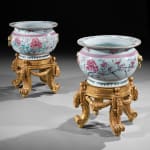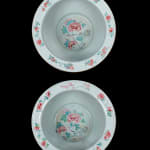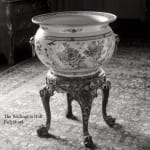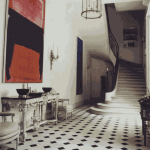WORKS FOR SALE
THE SCHLUMBERGER FAMILLE ROSE FISH BOWLS
D: 24” / 57cm
Further images
Provenance
Mrs. Maria da Conceição (São) Schlumberger (1929-2007)
The Chinese Porcelain Company, New York
Literature
George C. Williamson, The Book of Famille Rose, Tokyo, 1970, pl. LIII
Patricia F. Ferguson, Ceramics: 400 Years of British Collecting in 100 Masterpieces (London: 2016)
Rose Kerr, Chinese Ceramics: Porcelain of the Qing Dynasty 1644–1911 (Victoria and Albert Museum, 1986)
Teresa Canepa, Chinese Porcelain in the Eighteenth Century: The Koç Family Collection (Paul Holberton Publishing, 2020)
Stacey Pierson, Collectors, Collections and Museums: The Field of Chinese Ceramics in Britain, 1560–1960 (Bern, 2007)
The Schlumberger Fish Bowls
A Pair of Chinese Yongzheng Period Famille-Rose Fish Bowls
China, Qing Dynasty, Yongzheng Period (1723–1735)
Each bowl with a generous, globular body rising to an everted lip. The exterior is brilliantly enamelled in the famille-rose palette with blossoming tree peonies and floral sprays, accompanied by birds perched on and flying between flowering branches of prunus and magnolia. The composition is vivid yet harmonious, capturing the elegance and technical finesse of Chinese early eighteenth-century enamel work.
Around the upper shoulder runs a narrow lilac-pink frieze, edged with gilded borders and punctuated by applied biscuit lion-mask handles with gilt-metal drop rings that imitate bronze mounts. Beneath the main floral reserve is a lappet border of stylised lotus petals, outlined in iron red and filled with pale turquoise, which encircles the foot rim. The interiors are painted with further floral sprays, including peonies and cherry blossoms, rather than the more usual depiction of fish and aquatic plants. This unusual choice suggests a decorative or alternative functional purpose, particularly within a European context.
Context and Function
Porcelain bowls of this type were most likely made in Jingdezhen in Jiangxi province, the principal centre for imperial ceramics, and subsequently decorated in Guangzhou (Canton) where famille-rose enamels were perfected for the export trade. The form derives from archaistic bronze censers known as gui and first appeared in porcelain in the 1720s.
While large bowls of this type were originally used for housing ornamental fish, the present pair’s floral interior decoration and European mounts indicate they were reinterpreted in the West as jardinières, wine coolers, or cisterns. This repurposing mirrored European cisterns in silver or porcelain, often similarly fitted with drop-ring handles and displayed in pairs on stands.
Comparative Examples
Related examples can be found in major European collections:
- A pair with similar peony decoration in the White Sea Hall, Royal Palace, Stockholm.
- Another pair in the state apartments of the Royal Palace, Turin.
- A closely related bowl at Wallington Hall in Northumberland, described in 1769 by Arthur Young as a “noble china cistern”, with identical lion-mask handles and comparable decoration.
- A comparable bowl with butterflies and floral sprays, formerly in the collection of Sir Philip Sassoon, illustrated in George C. Williamson, The Book of Famille Rose, Tokyo, 1970, pl. LIII.
- Another example at Blickling Hall, Norfolk.
The association with goldfish culture in eighteenth-century England adds further context. Goldfish were first recorded in Britain in 1691 and were imported more routinely from the 1730s, often via private trade. Charles Lennox, 2nd Duke of Richmond, is known to have kept goldfish in a Chinese vessel at Goodwood, and Horace Walpole bred them at Strawberry Hill. The Goodwood bowls, which remain in situ, bear close comparison to the present pair.
Over time such vessels often evolved in function. The Wallington cistern, for example, was repurposed as a jardinière in the early nineteenth century and later filled with water in the 1920s to entertain children. This versatility and enduring appeal speak to their use as both decorative and functional objects.
Technical and Artistic Merit
These bowls show the technical brilliance and decorative refinement of the Yongzheng reign. The even glaze, precise and confident decoration, and crispness of the applied masks reflect the exceptional standards of Jingdezhen production in the early Qing period. The colour palette, dominated by soft turquoise, deep rose pinks, and finely shaded greens, achieves both harmony and vibrancy, qualities that are characteristic of the finest famille-rose decoration. In both scale and condition, this pair represents an extremely rare survival, further enhanced by their grand European mounts.
Provenance: São Schlumberger
This pair was in the collection of São Schlumberger (1929–2007), celebrated collector and patron, and wife of oil magnate Pierre Schlumberger. The couple’s Paris home, the Hôtel de Luzy on the rue Férou, was a landmark of cosmopolitan opulence, designed by Pierre Barde, Valerian Rybar, and Daigres in a striking blend of classical and contemporary styles.
Mrs Schlumberger had a particular passion for large-scale Chinese porcelain and owned multiple pairs of famille-rose fish bowls. Their impressive scale, refined palette, and grand mounts perfectly matched the theatrical and curated interiors she created. A different pair of fish bowls appears in a photograph of her Avenue Charles Floquet apartment by Eric Bowman, published in Vanity Fair (“The Wow of São,” October 2010), where they can be seen amid a dramatic display of furniture and works of art that epitomised her distinctive taste.







